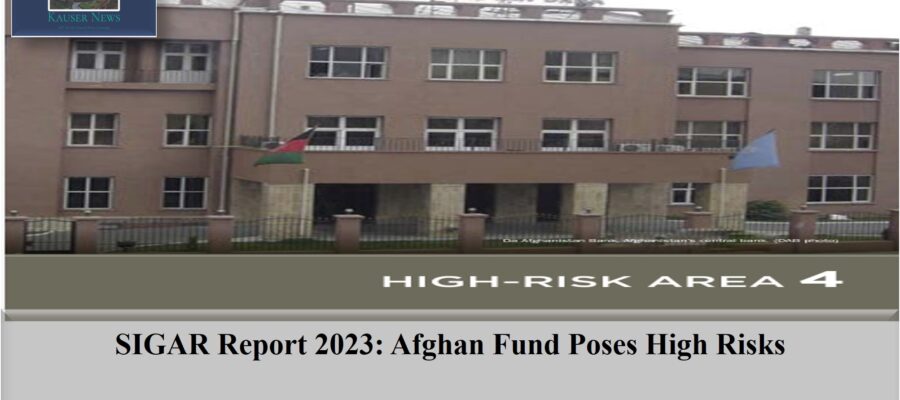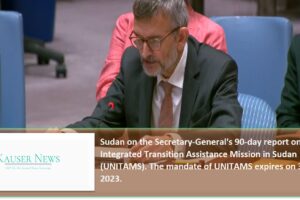The U.S. government established the Fund for the Afghan People in September 2022 to provide $3.5 billion in frozen Afghan central bank assets for the benefit of the Afghan people.
the Afghan Fund poses significant risks, including the potential for funds to be diverted to the Taliban or other malicious actors.
According to SIGAR Report:
On September 14, the U.S. Departments of Treasury and State jointly announced the establishment of the Fund for the Afghan People—also known as the “Afghan Fund”—to provide $3.5 billion in frozen Afghan central bank assets for the benefit of the Afghan people.
The Afghan Fund is incorporated as a Swiss charitable foundation and aims to protect, preserve, and make targeted disbursements of Afghan central bank reserves to help provide greater macroeconomic and financial stability to Afghanistan.87 As of early January 2023, the Afghan Fund had not made any disbursements, and the nature and scope of the Fund’s future activities are still to be determined.88 According to State, the Fund is “explicitly not intended to make humanitarian disbursements.”89 The $3.5 billion is part of $7 billion in assets that Da Afghanistan Bank (DAB), Afghanistan’s central bank, had deposited in the United States prior to the Taliban takeover of Afghanistan in August 2021.
On February 11, 2022, President Joseph R. Biden issued an executive order declaring that Afghanistan’s widespread humanitarian crisis and potential for a deepening economic collapse constituted an “unusual and extraordinary” threat to U.S. national security, and, as such, rose to the level of a national emergency. The order further declared that the preservation of DAB assets held in the United States was critical to addressing this emergency and ordered the freezing of all such assets.
According to a fact sheet accompanying the executive order, the order was designed to provide a path for DAB funds to reach the people of Afghanistan while keeping them out of the hands of the Taliban and malicious actors.91 Simultaneous with the executive order, the U.S. Department of the Treasury’s Office of Foreign Assets Control (OFAC) issued a license authorizing the transfer of one-half of DAB’s U.S.-based assets—$3.5 billion—to a separate financing mechanism or other entity for “the benefit of the people of Afghanistan” upon instructions from the individual(s) certified by the Secretary of State per section 25B of the Federal Reserve Act.92 Per the executive order, the other half—another $3.5 billion—of DAB reserves held in the United States would remain subject to litigation by several groups of plaintiffs, including U.S. victims of the September 11, 2001, attacks, who have pursued legal claims to the assets to satisfy court judgments against the Taliban.93 On February 21, 2023, U.S. District Court Judge George Daniels ruled against those plaintiffs.
The Court found that it was “constitutionally restrained from determining the Taliban is the legitimate government of Afghanistan as required to attach DAB’s assets,” as “the President has the exclusive power to grant formal recognition to a foreign sovereign.
According to reporting from the New York Times, a lawyer representing relatives of 9/11 victims who had sought compensation using DAB funds indicated that his clients intended to appeal the ruling. It remains to be seen whether the $3.5 billion still in the United States will eventually be transferred to the Afghan Fund.95 Another approximately $2 billion in Afghan central bank assets held in Europe and the United Arab Emirates could also be added to the Fund.
The Taliban’s interference in Da Afghanistan Bank (DAB), Afghanistan’s central bank, poses a serious risk to the Afghan Fund.
The Taliban have appointed loyalists to senior roles at DAB, and they have rejected Afghanistan’s constitution under which the banking law—and DAB’s statutory independence—was established.
State and Treasury have indicated that they will not support the return of funds to DAB until certain criteria are met, including evidence that DAB is independent of political influence and interference, and has adequate controls in place to prevent money laundering and funding terrorist groups.
Even if the Taliban were to take some conciliatory move toward meeting the United States’ criteria for transferring funds, considerable risks remain in ensuring that monies transferred to the Afghan Fund are used for their intended purpose.
In four high-risk lists issued from 2014 to 2021, SIGAR identified inadequate oversight of reconstruction programming as a key area of concern. Additionally, SIGAR has previously reported that the 2010 near-collapse of Kabul Bank due to extensive fraud and embezzlement—the scale of which necessitated an $825 million bailout—highlighted the limitations and challenges of monitoring and oversight in Afghanistan.
Effectively monitoring DAB under current circumstances is likely to be even more challenging, as the United States no longer has an official presence in Afghanistan. Additionally, it may be difficult for the Afghan Fund—which consists of four trustees and is based in Switzerland—to effectively oversee any activities conducted on the ground in Afghanistan.
The Afghan Fund’s board of trustees has met twice since its establishment, but it has yet to make any decisions about the Fund’s activities or control measures. The board has agreed to invite two additional candidates to join the board, has initiated a process to hire an executive secretary, an external auditor, and a compliance service provider, and has begun to recruit stakeholders to participate in an Afghan Advisory Committee.
USAID is funding its own $3.5 million, third-party assessment of DAB focusing on its commercial bank and payments departments, and its anti-money laundering/countering the financing of terrorism capabilities. The assessment is expected to deliver its final report in April 2023.
SIGAR is concerned about the risks posed by the Afghan Fund and is calling for more transparency and oversight of the Fund’s activities. SIGAR is also calling for the United States to work with the international community to develop a comprehensive plan for the future of Afghanistan’s banking sector.
SIGAR Report 2023: Afghan Fund Poses High Risks
The Taliban’s interference in Da Afghanistan Bank (DAB), Afghanistan’s central bank, poses a serious risk to the Afghan Fund. The Taliban have appointed loyalists to senior roles at DAB, and they have rejected Afghanistan’s constitution under which the banking law—and DAB’s statutory independence—was established.
State and Treasury have indicated that they will not support the return of funds to DAB until certain criteria are met, including evidence that DAB is independent of political influence and interference, and has adequate controls in place to prevent money laundering and funding terrorist groups.
Even if the Taliban were to take some conciliatory move toward meeting the United States’ criteria for transferring funds, considerable risks remain in ensuring that monies transferred to the Afghan Fund are used for their intended purpose.
In four high-risk lists issued from 2014 to 2021, SIGAR identified inadequate oversight of reconstruction programming as a key area of concern. Additionally, SIGAR has previously reported that the 2010 near-collapse of Kabul Bank due to extensive fraud and embezzlement—the scale of which necessitated an $825 million bailout—highlighted the limitations and challenges of monitoring and oversight in Afghanistan.
Effectively monitoring DAB under current circumstances is likely to be even more challenging, as the United States no longer has an official presence in Afghanistan. Additionally, it may be difficult for the Afghan Fund—which consists of four trustees and is based in Switzerland—to effectively oversee any activities conducted on the ground in Afghanistan.
The Afghan Fund’s board of trustees has met twice since its establishment, but it has yet to make any decisions about the Fund’s activities or control measures. The board has agreed to invite two additional candidates to join the board, has initiated a process to hire an executive secretary, an external auditor, and a compliance service provider, and has begun to recruit stakeholders to participate in an Afghan Advisory Committee.
USAID is funding its own $3.5 million, third-party assessment of DAB focusing on its commercial bank and payments departments, and its anti-money laundering/countering the financing of terrorism capabilities. The assessment is expected to deliver its final report in April 2023.
SIGAR is concerned about the risks posed by the Afghan Fund and is calling for more transparency and oversight of the Fund’s activities. SIGAR is also calling for the United States to work with the international community to develop a comprehensive plan for the future of Afghanistan’s banking sector.





